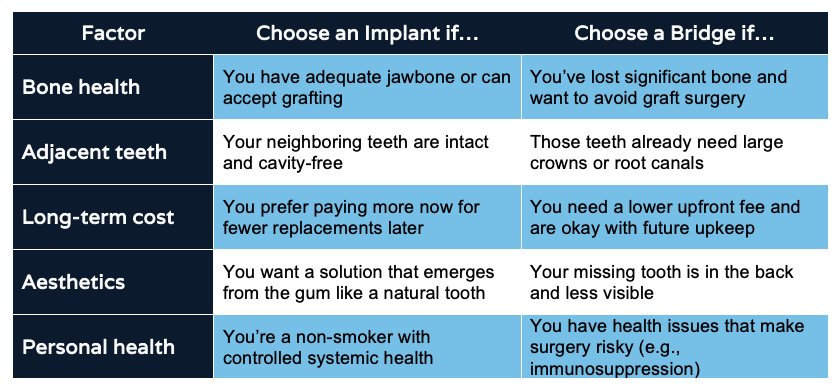
Expert dental tips, news, and smile advice

Expert dental tips, news, and smile advice
[Image: Middle-aged professional speaking with a dentist, weighing tooth-replacement models on a small tray]
Marisol, a 42-year-old event planner in Newark, remembers the night she felt her front premolar crack. The timing couldn’t have been worse: she had a high-profile wedding to direct in three weeks. Her dentist at the ER told her she’d need the tooth extracted, then gave her two replacement paths—a fixed bridge or a single dental implant.
At first glance the bridge seemed simpler (“No surgery!”). But Marisol wondered: Would a bridge feel as solid as her own tooth? What would it look like ten years from now? Those questions echo what we hear every week at 50 Commerce Dental Center—and they go deeper than price tags.
This guide breaks down the clinical facts and the lived-in realities so you can choose a solution that fits your smile, schedule, and budget for the long haul.

A conventional bridge anchors an artificial tooth (pontic) to the two neighboring teeth after they’re shaved down for crowns. You walk out with a full smile in two visits. Insurance often covers a larger share because bridges have decades of actuarial data behind them.
A dental implant replaces the root, not just the crown. A titanium post is surgically embedded, a healing period passes, then a custom crown is attached. Healing time now averages 10–12 weeks with today’s surface-treated implants—far shorter than in the early 2000s.



An implant transmits chewing forces through bone, so most patients forget which tooth is the implant within six months. A bridge, by contrast, sits on top of trimmed teeth and can feel slightly “taller” or “hot-cold sensitive” in the early weeks.
Gums thin naturally with age. Around an implant, the gum-bone interface tends to remain stable if oral hygiene is strong. Under a bridge, gum recession can reveal the bridge margins, creating a dark gumline line in photos—one reason people request replacements sooner than the average lifespan.


Bottom line: Implants cost more upfront but often equalize (or beat) the bridge by year 12—provided you care for them like natural teeth.

“Look at your smile not just as it is now but as it will be the year you retire,” Dr. Saul Weiner often says during consultations.
If you’re thirty-something with sturdy neighbor teeth, we usually lean implant. If the adjacent teeth already need crowns, a bridge may solve two problems at once.
We also remind patients that longevity equals partnership: your hygiene habits and our checkups must sync. Our team schedules a 48-hour post-restoration call and six-month tune-ups to catch micro-changes early.

Modern grafting materials integrate in 4–6 months. The process adds cost, but it also restores jaw contour—something a bridge alone can’t do.
Yes, but remember the prep work: those trimmed teeth will always need crowns afterward. You’d be paying for two full treatments, not one.
Coverage is improving. Many PPO plans now reimburse for the surgical phase but cap it at 50%. Our front-office team pre-files estimates so there are no surprises.


Q1. Does an implant ever fail?
Failure rates hover around 2–4% nationally, often due to smoking or uncontrolled diabetes. At 50 Commerce Dental Center in Newark, we use surface-modified implants that bond faster, and we screen systemic risk factors so candidacy is transparent from day one.
Q2. How painful is the implant surgery compared to an extraction?
Most patients describe implant placement as easier than the original tooth removal. Local anesthesia numbs completely, and post-op soreness is manageable with over-the-counter analgesics for 24–48 hours.
Q3. What’s the biggest hidden cost people forget?
A bridge replacement isn’t just a new prosthesis—it often involves core build-ups on the anchor teeth. That can add $400–$600 beyond the bridge fee a decade later.
Q4. Can a bridge damage the anchor teeth?
Yes. Because chewing forces concentrate on the crowned teeth, they’re at higher risk for fractures or secondary decay. Our clinicians use digital bite-pressure mapping to fine-tune occlusion, but biology still matters.
Q5. How do dietary choices differ after each option?
Implant patients resume a normal diet—corn-on-the-cob included—once osseointegration completes. Bridge wearers should avoid chewing ice or un-popped popcorn kernels, as lateral forces can loosen cement over time.

Schedule a personalized consultation and 3-D scan at our downtown office: (973) 755-2575. Or explore more on our site:
We’ll walk through your clinical picture, budget, and timetable—no pressure, just clarity.
[Image: Dentist holding a 3-D printed jaw model while a patient tests bridge flossing with super-floss]
Discover the best solution for your smile at 50 Commerce Dental Center. Schedule your appointment now and let our expert team guide you to a confident, healthy smile.
.jpg)
Book your appointment today and take the first step toward a healthier, more confident smile.
Note: Not acceptingMEDICAIDat this time. Questions? Call(973) 755-2575.